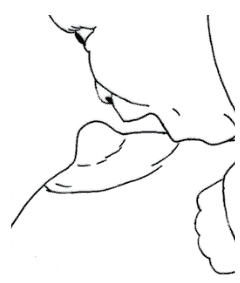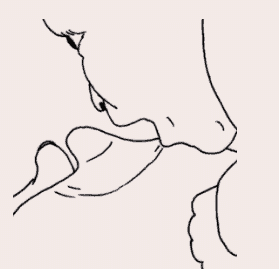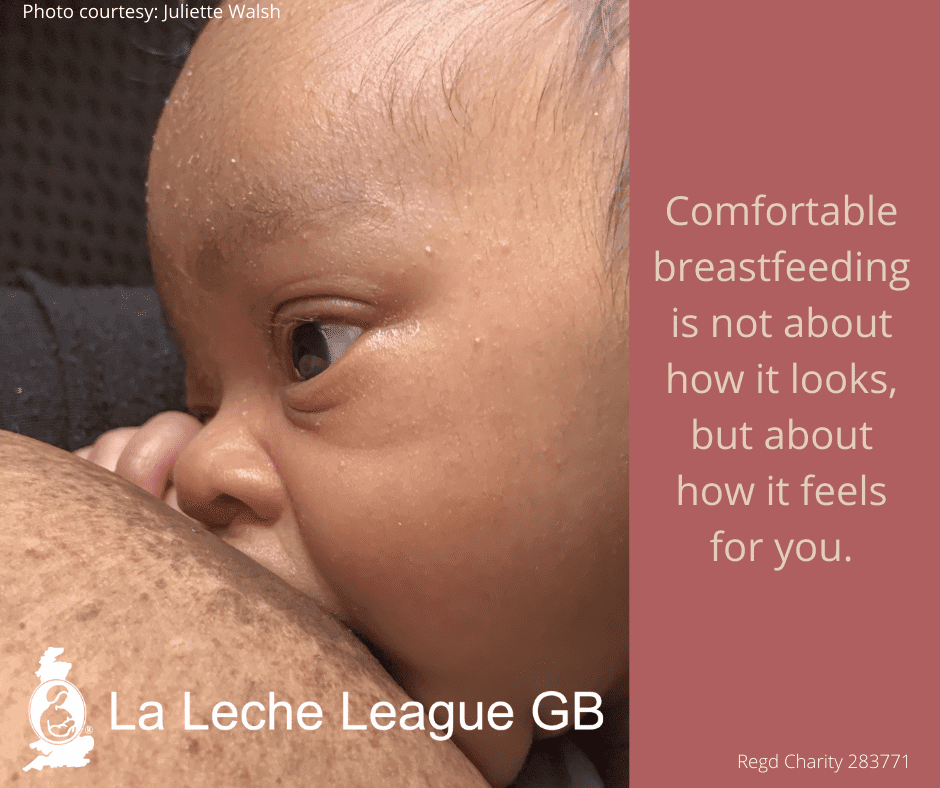Getting your baby positioned and attached comfortably at the breast is an art—mothers often say it takes a little while for breastfeeding to feel entirely comfortable and natural, even if they’ve breastfed before. In the past girls grew up learning about breastfeeding by watching mothers in their families and communities. These days many of us become mothers having never seen a baby breastfeed.
But breastfeeding has worked for mothers and babies for thousands of years and it can work for you too.
Many babies can find their way to the breast by themselves, especially if they haven’t been too affected by birth interventions. Other mums and babies need a little longer to work it out with maybe some help from a skilled breastfeeding supporter such as an LLL Leader.
When all is going well, specific holds and positions don’t really matter because you and your baby will work out what suits you best. However if you are finding it awkward, uncomfortable or downright painful then the following information is designed to help you think about where you can make adjustments and get breastfeeding working comfortably for you.
Good positioning and attachment is important for maintaining milk production. A baby who attaches deeply at the breast is able to remove milk effectively. This is important for maintaining milk production. Well-drained breasts make milk quickly. If there is any concern about how much milk you are making, working on improving positioning and attachment is an important first step.
There’s no ‘right’ or ‘wrong’. If you are comfortable, your baby is producing plenty of dirty nappies and is gaining weight after the first few days, then breastfeeding is going well for you. There are no rules—but there are a few principles that can help you work out what to do if things aren’t going well: see Latching on – getting a good attachment.
Positioning describes how you sit or lie and how you support your baby as he takes the breast. How you hold your baby can make a big difference to how well he can breastfeed. Even small adjustments can be significant. Attachment describes the way he latches onto the breast.
Tips for getting started
The laid-back approach
Latching on – getting a good attachment
Different breastfeeding positions
As time goes by
Tips for getting started
If it hurts then make changes
If it doesn’t feel right to you, then it isn’t fine, whatever anyone says. Pain is your body’s way of letting you know something is wrong. Start by trying to improve positioning and attachment. A few quick adjustments to how you are sitting or lying or how your baby comes towards the breast may be all that are needed.
Sometimes it can take a little longer. You may need to work with one or more skilled breastfeeding supporters over a period of time to get to the point where everything falls into place and breastfeeding starts feeling natural.
Each mother and baby pair is different and what works well for one mother and baby may not work for you. This is one reason why you may hear different suggestions from different helpers. You are the best judge of what is helpful so don’t be afraid to use what feels right for you and discard the rest.
Your baby needs to be calm
You can offer the breast at any time when you are both calm. You may even find it easier if your baby isn’t obviously hungry. Feed your baby before he needs to cry. Early cues for wanting to eat include suckingtheir hand, smacking their lips, turning their head towards you, or fussing. They won’t latch well if they are distressed. If your baby is upset take time to soothe them. Hold them upright against you, stroke them and talk to them. A little expressed colostrum or breastmilk given on a spoon can help to calm them if they are desperately hungry.
Your baby needs full body contact
When your baby is held in full body contact against you, they will feel stable and be better able to coordinate their movements. Laid back positions ensure full body contact. If you’re sitting up, you’ll need to hug your baby in as tightly as if you were standing up holding them against you. Babies who don’t feel stable tend to wave their arms around, which can make latching more difficult. Pillows can get in the way and aren’t always necessary. So wait until after your baby’s latched on, and then tuck them in only if you need them for support.
Some babies need time
Some babies find it difficult to latch on, or simply nurse ineffectively at the breast. Often a difficult birth or interventions during labour or birth are the cause. Giving a baby time to recover, and using laid-back breastfeeding positions with skin-to-skin contact can maximise your baby’s natural instinct to breastfeed. If your baby isn’t latching or feeding well seek help from an LLL Leader and read our page My Baby Won’t Breastfeed. With time and patience, most babies will breastfeed. In the meantime express your milk for your baby to maintain milk production and give you both the time to work it out.
Laid-back breastfeeding

Laid-back breastfeeding
Many people assume you have to sit up to breastfeed. Not so. In fact evidence suggests humans evolved to breastfeed in laid-back positions with our babies upright against our chests. You may have experienced this type of position when you had your first feed, soon after your baby’s birth. There is more and more evidence that laid-back breastfeeding positions (also called Biological Nurturing) help babies breastfeed more effectively and are more comfortable for mothers, especially in the early days and weeks.
Laid back breastfeeding is really useful for those first few days and weeks when you want to rest and recover and your baby needs to be in close contact with you to get breastfeeding established. It can be done skin-to-skin or with you both lightly dressed. You don’t have to be in bed; the sofa or a reclining chair is a comfortable alternative.
You can also use laid-back breastfeeding principles when sitting in an upright chair by shifting your weight back onto your tail bone and reclining your body back a little, to open up a space for your baby. This allows more of their weight to be supported by your body and less by your arms. It isn’t safe to sleep with your baby on a chair or sofa.
Sleepy babies
If your baby is sleepy, perhaps because of birth interventions, then using laid-back positions with skin-to-skin contact can encourage your baby’s interest in feeding. In laid-back positions babies often attach and feed when in light sleep so it helps to spend substantial periods of time with your sleepy baby against you. When you notice the little movements that indicate your baby is moving into a light period of sleep you can encourage them to latch.
How laid back breastfeeding works
- You lay back in a comfortable, supported semi-reclining position (not flat) that opens up your body, creating space for your baby.
- Your baby lies against you, their whole front against your body, vertically or at any comfortable angle.
- Your baby feels stable and secure and their instinctive feeding reflexes are triggered, prompting them to bob their head and seek out the breast.
- Gravity helps them latch deeply and stay latched, rather than hindering the process.
- Your hands are free to support and caress your baby and help them attach.
- Your body releases the hormones that stimulate milk production and make you experience loving feelings towards your baby.
- There are no rules—you and your baby are free to work it out between yourselves.

If you have twins or more, laid-back positions can allow you to feed two babies at once with less need for cushions or helping hands.
Latching on — getting a good attachment
- Your baby needs to tip their head back and reach forward with their lower jaw. As your baby tips their head back their jaw drops and their mouth opens wide, so they can anchor their chin and lower lip firmly against your breast. If they have to tuck their chin in to reach the nipple they won’t be able to open their mouth so wide. Tipping their head back also makes a deep latch possible, swallowing easier, and frees up their nose for comfortable breathing. In laid-back positions lay your baby with their head between your breasts. If you are sitting up, keep your supporting hand away from the back of their head. Babies tend to creep forward, so try shifting them so that their eyes and nose are opposite the nipple to encourage them to reach forward and anchor their chin first. In sitting or side lying positions a little push between the shoulder blades with your supporting hand or arm as they latch brings their chest in closer and helps their head tip back.

- Your baby needs a big mouthful. When a baby chews on a nipple, this compresses the milk ducts, prevents milk flowing and hurts. When a baby has a good big mouthful of breast beyond the nipple, breastfeeding is comfortable and milk can flow. Some women like (or need) to hold their breast when nursing. They flatten their breast as they would a big sandwich they were offering to the baby, matching it to the oval of his mouth. This can help their baby grasp more breast tissue. It doesn’t matter if fingers are closer to the upper jaw but try to keep the “lower jaw fingers” out of your baby’s way. Biological Nurturing™ positions make use of gravity to help a baby get a bigger mouthful.

Our own video below demonstrates flipple technique (aka exaggerated latch), it can be very helpful for getting an effective pain free latch:
- Let your breast rest at its natural level. It can be tempting to lift your breast and move it towards your baby’s mouth. If you do this, your baby probably won’t get a full mouthful, and after a while your hand will get tired and the breast will drop and slip out of their mouth. Breastfeeding pillows can get in the way too because they lift a baby up too high and prevent you tucking them in against your tummy. See where your breasts naturally rest and hold your baby accordingly. If you need them, tuck pillows in after they are well attached.
- Bring baby to breast, not breast to baby. Since breasts are attached to you and you baby is moveable it makes much more sense to bring your baby to the breast, not the other way round! And it works better too. With their body tucked firmly against you (or laid on top of your body), your baby will feel more stable and have better head control, and you’ll feel a lot more comfortable too.
- It’s easier to latch onto a softer breast. It’s much easier to get a deep mouthful if the breast is soft so breastfeed frequently to avoid engorgement. When your baby bobs their head and licks the nipple, it naturally makes it easier to latch on. If your breast is full and hard, you can use reverse pressure softening to move fluids away from the nipple area so your baby can latch on well. Apply gentle steady pressure with your fingertips on the areola around your nipple for about a minute. You can also press with the sides of your thumbs or fingers. Denting the breast at the edge of the areola with a finger and placing your baby’s chin in the dent may also help. Gently hand express a little milk too if needed.
- Your baby needs to choose his own timing. Your baby will probably do best if they pick the moment to latch on. You can help by supporting them in a position that lets them do this when they are ready. To encourage your baby to gape hold them close against you, close enough to the breast so they know the nipple is there, but where they can’t quite reach it. Be prepared for your baby to lick and nuzzle for several minutes before they are ready to open wide.
The natural or laid-back breastfeeding positions shown in the following videos can be a great help in encouraging your baby to latch on well, as well as being comfortable for you. You can recline comfortably with your baby on top of you with their whole front against you and their body completely supported by yours.
Best Beginnings’ video demonstrates clearly how to make sure your baby is attaching well to the breast, you can view it here.
This video from Global Health Media demonstrates how to enable your baby to latch deeply on to your breast so that breastfeeding is comfortable for you and means your baby get enough milk:
This video from Raising Children.net.au shows how to attach your baby well, and shows a variety of comfortable breastfeeding positions:
Using different breastfeeding positions
The cradle hold
Although the cradle hold is one of the most common nursing positions it can be a challenge for new mothers to learn. You need to hold your baby’s body firmly against you to give them stability because their weight is supported mainly by your arms. Shifting so you are sitting on your tailbone, rather than upright can help stability and reduce the strain on your arms (see picture right). It can be difficult to control a baby’s head and to keep them high enough and close enough to your breast. A small baby may tend to curl up in a ball in this position if not pulled in closely enough against your body. It may not be the best choice at first if you’re experiencing any problems with latch-on, milk transfer or if you have sore nipples. Once you’re more confident with breastfeeding, you may find you use a version of the cradle hold much of the time, especially when out and about.

Tuck your baby’s body firmly against yours.

- Your baby’s whole front is against your tummy, their hip resting on or near your thigh, tucked around you like a comma. Their chest will be snuggled into the breast and your nipple near their nose.
- Their head is resting on your forearm and/ or wrist (not the crook of the elbow).
- As your baby opens their mouth to take the breast, pull their body in firmly against you.
- Once your baby is attached, settle back a little for your own comfort and so that more of their weight is taken by your body.
Laid back breastfeeding
Remember that Biological Nurturing™ positions aren’t just for the first week or two. They can be really useful later on when you want to relax, and especially if you are breastfeeding more than one baby or if your baby is fussy or unwell.

The cross-cradle hold
The cross-cradle position can be useful in the early days because it gives you more control in guiding your baby to the breast. It can be uncomfortable to maintain without good support under your arms, especially with larger babies, so once your baby is attached, switch arms as shown in the picture below. After the first few weeks and as your baby grows longer and heavier, you may prefer to use other comfortable holds. Avoid touching the top or back of your baby’s head because it often causes a baby to pull back from the breast. Forcing a baby onto the breast by firmly holding the back of the head usually has the opposite effect and can put a baby off breastfeeding.
Cross cradle

- Tuck their whole front against your tummy, their hip near or resting on your thigh.
- Your hand supports their neck (not the back of the head) with your palm between their shoulder blades.
- Your other hand is free to shape or stabilise your breast if needed.
- Make sure your baby isn’t too far round the front—line them up so their eyes and nose are near the nipple.
- As your baby opens their mouth, give a little push with the palm of your hand to bring their chest in close against you.
- This will help their head tip back and let them plant their chin deeply against your breast.
- Once your baby is attached you can bring your other arm round to support your baby’s body and settle back a little for your own comfort and so that more of his weight is taken by your body. Hold your baby with the arm opposite to the breast he’s going to latch onto.
The underarm (clutch or rugby) hold

The underarm hold is useful if you have had a caesarean birth. It helps keep the weight of your baby off your incision. It is also a good position for mothers with flat or inverted nipples and for babies with latch-on or sucking problems because it offers you a good view of baby and breast and control of your baby’s head. You can also feed two babies at once in this position. For larger, longer babies you may need extra cushions behind your back to bring you further forward and allow space for your baby’s length.

- Your baby’s front is close against your side, with your hand under their shoulders and neck.
- Your elbow keeps them tucked closely against your body.
- Your baby approaches your breast from below. This can work well if you have large breasts. If you have smaller breasts you may need to bring your baby into a semi-sitting position.
- Make sure your baby isn’t too far round the front. You may need a cushion between your back and the chair back to allow room for your baby’s length and prevent them pushing themselves forward with his feet.
Side lying

This side-lying position is helpful if you are recovering from a caesarean birth or an episiotomy and invaluable for nursing in bed during the night.
It can take a while to get the knack but it’s well worth persisting because it can make night feeds so much easier.
Some mothers decide to sleep with their baby alongside them. Others choose to move their baby back onto a separate sleep surface.
Safe Sleep and the Breastfed Baby will help you decide on the safest sleep arrangements for your family, based on your own individual circumstances.
• Lie on your side, with your knees bent up and a pillow under your head.
• Place your baby on their side facing you so that their body and your body form a V-shape, meeting at your hips, with your nipple level with their nose or eyes.
• You can put your arm under your baby’s head as shown, or up by the pillow with your baby lying on the bed.
• As your baby latches, give a little push between their shoulder blades to bring their chest in closer and help their head to tip back and their mouth to
open wide.
• You may find it helpful to tuck a small pillow or rolled blanket behind the small of your back and/or between your knees.
Standing up

At some feeds babies just do better if you stand up. You can sway or bounce gently to help calm your baby, and the lack of a lap can be helpful. As always keep your baby nice and stable and let them lead the way. Try angling their legs down instead of holding them horizontal, and see what happens. Or try starting with them against your shoulder, supporting them as he moves down to the breast. Even when using other positions, sometimes just standing up and sitting down again straight away helps everything settle into a comfortable position.
As time goes by
Whether you choose to breastfeed sitting up, reclining or lying on your side, you will need to adjust how you support your baby as he grows in length and weight. Use the principles shown here as you experiment with different positions. Sometimes there are physical or medical causes for pain or discomfort such as tongue tie or a thrush infection. If you are still finding it difficult to get comfortable, do persist with seeking further and continued support. There is almost always a breastfeeding solution to breastfeeding problems. You can contact an LLL Leader by calling our Helpline. You can also find support and encouragement from breastfeeding mothers in your local LLL group.
Written by Sue Upstone, Karen Butler and mothers of LLLGB

Further Reading
The Womanly Art of Breastfeeding. LLLI. London: Pinter & Martin, 2010.
Mastitis
Beginning Breastfeeding
Breastfeeding Your Baby – easy read
Caesarean Birth & Breastfeeding
Comfortable Breastfeeding – easy read
Skin-to-Skin
Engorged Breasts – Avoiding & Treating
Hand Expression of Breastmilk
Inverted Nipples
My Baby Needs More Milk
My Baby Won’t Breastfeed
Nipple Confusion?
Nipple Pain
Nipple Shields
Nursing Supplementers
Safe Sleep & the Breastfed Baby
Sleepy Baby – Why & What To Do
Tongue Tie
Too Much Milk & Oversupply
LLLI Resources
Position to breastfeed
Other resources
How to do Biological Nurturing: www.biologicalnurturing.com/video/bn3clip.html
Best Beginnings videos to watch online: www.bestbeginnings.org.uk/watch-fbtb
References
Breastfeeding Answers Made Simple. Mohrbacher, N. Amarillo, TX: Hale Publishing, 2010.
Biological Nurturing: Laid-back breastfeeding for mothers (DVD). Colson, S. et al. 2012.
An Introduction to Biological Nurturing; New angles on breastfeeding, Colson S. Amarillo, TX: Hale Publishing, 2010.
Supporting Sucking Skills, Watson Genna, C. Burlington, MA: Jones & Bartlett, 2012.
This information is available to buy in printed form form the LLLGB Shop.
It is also available in kindle edition.
Information, references and links on this page are taken from La Leche League resources, unless stated otherwise. Please note that LLLGB does not endorse information from outside sources, extra information is provided for you to consider. Information supplied is not intended as advice, and you are in the best position to make a decision as to how the information offered will affect you and your baby.
Copyright LLLGB 2016



